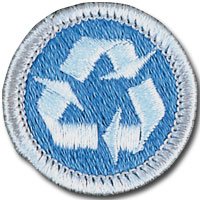 Click here for the official guidelines from the Boy Scouts of America for the Environmental Science Merit Badge.
Click here for the official guidelines from the Boy Scouts of America for the Environmental Science Merit Badge.
Environmental science is the study of the natural world. The plants that we grow in our self-watering container gardens engage in the same behaviors and rely on the same basic processes of life as plants living wild, in cultivated fields, or in yards and gardens. By studying the plants in your self-watering container garden, you can study the life processes used by plants in nature.
One activity that you can choose to perform for this badge is to conduct an experiment to find out how living things respond to changes in their environments. This can be done simply enough by starting seedlings in identical conditions and then separating them into groups and testing how each group responds to different environmental changes.
For example, one could test the influence of water quality on plant development by dividing the seedlings into three groups and then watering each group with only the same type of water from that point forward; Group 1 could be watered with tap water, Group 2 could be watered with store-bought bottled water, and Group 3 could be watered with water run through a Britta® filter. After a few weeks, you could take data on how the plants in each group are developing relative to the plants in the other groups. Or, you could conduct similar tests regarding differences in lighting conditions, temperature, humidity, soil quality, fertilizer type, and any other facet of gardening that can be experimentally manipulated.
Another option is to conduct an experiment illustrating the greenhouse effect. (For more information on greenhouse-oriented projects, see the Energy Merit Badge.) This can be accomplished by simply putting a plastic baggie over a cup with a moist seedling pod in it and setting it on a warm, sunny windowsill.
Yet another option is to conduct an experiment to show how living things react to thermal pollution. You could subject seedlings to different temperature conditions, as mentioned above, to satisfy this component of the badge.
An additional option is to look around your home and determine ten ways your family can help reduce pollution, while another option is to determine ten ways to conserve resources or use resources more efficiently in your home, at school, or at camp. These lists could be quite similar and, if you have a self-watering bucket container garden, then you can build a list for either of these options.
Consider that when you grow your own food, you eliminate the packaging- and transportation-related pollution associated grocery store chain sales of large-scale commercially grown produce. You also reduce water usage compared to an in-ground garden; your self-watering containers should only need to be topped off once a month or so, unless you live in a very dry place, in which case, you’ll have to top them off more frequently. You know they are full when water comes out the weep holes as you’re filling them through their PVC pipes.
You can also recycle materials for your gardening supplies. Sometimes, 5-gallon buckets aren’t that hard to come by; they are used for a wide variety of purposes by many different industries. Parents’ employers are sometimes good sources for used 5-gallon buckets, so long as they have never been used to contain anything caustic or poisonous. Used non-BPA, food grade buckets can be obtained from large kitchens, restaurants, school cafeterias, etc., where bulk food is purchased.
Your troop or crew may seek donations of building materials from hardware stores, garden suppliers, nurseries, landscaping companies, and contractors to support its service-oriented gardening projects. For-profit companies that want to donate self-watering bucket container materials and tools to Boy Scouts can contact us to coordinate their donations. Scout leaders can also contact us so we can put you in touch with any possible donors.
Another way to reduce pollution and use resources more efficiently in your home is to compost your green waste, such as fruit and vegetable scraps. If you are using worms to help compost your green waste, do not include citrus in your scraps. Composting puts materials that would have otherwise been hauled away in the garbage into productive use. Green waste is mixed with brown waste (newspaper shreds, coconut coir, dry leaves, hay, etc.), then is wetted and stirred once a week or so. Over time, the chemical reactions of decomposition reduce the waste down into rich, brown compost that can be put into your buckets and stirred into the soil when you change over the plants.
If your composter has a drain spout or spigot, you can collect the water run-off, which is called “compost tea,” and pour it down the spouts of your self-watering bucket containers. You can also apply it to the top of the soil so long as you dilute it with clear water first. If you over-feed your plants with nutrients, you can burn the roots and kill them. If you pour the compost tea into the reservoirs, the nutrients can be wicked up into the soil with the water. However, a lot of it will collect on the bottom of the reservoirs as sediment, so a diluted solution from the top may work best.
Periodically, usually after a growing season ends and you’re going to have to prep a bucket container for the next growing season, anyway, you may want to separate the upper bucket from the reservoir and recycle the sediments out of the bottom of the reservoir by rinsing them back into your composter or into separate big bucket as compost tea. Then, you can refill the reservoirs with fresh water, put the upper buckets back in, mix a few handfuls of compost into the soil, and water the soil from the top with compost tea to get it ready for the next planting. Your next generation of sprouts will love you!
You can also spread a layer of compost on the top of the soil in each planted bucket around the bases of the plants and then water it gently from the top to push the nutrients from the compost down into the soil. If you are using worms in your composter, it’s not a bad idea to pull some out and put a few in the soil of each of your self-watering bucket containers. They aerate the soil, which helps get needed air to the roots, and they produce worm castings (poop) that fertilizes the soil further, particularly when you’ve put yummy compost in your buckets. Worms will help move the nutrients through the soil to the roots of your plants.
Composting is nature’s recycling act. You can take advantage of it by turning your green and brown waste into nourishing food for your plants, which become nourishing food for you. The green wastes created by the plants you grow then go back into your composter and are, therefore, themselves recycled. How much pollution can you eliminate from a self-perpetuating recycling process like this? What isn’t going into landfills? What isn’t being trucked half-way across the continent to end up on your plate? How many ways can self-watering container gardening be used to reduce pollution or make more efficient use of existing resources?
Return to Boy Scouts Page
